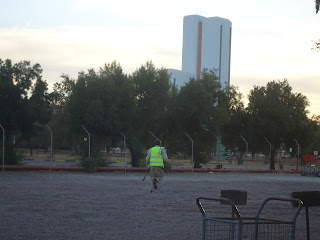This past week was probably the busiest yet (hence the lack of blogging). Allie and I got to see and do so many things that it would be impossible to list them all in a single post. Instead, I will briefly mention some of the highlights from the past few days.
Monday - I performed my first cat spay! The clinic obtained three female cats from the BSPCA and allowed me and another veterinary student from the University of Glasgow to sterilize them. Dr Mbatshi guided us through the procedure and offered help and tips when necessary. I was able to locate and ligate both ovaries and the cervix before removing them and closing up the incision. Mbatshi is an excellent and patient teacher, and the surgery went smoothly. Hopefully I will have the opportunity to practice my spay technique over the next few weeks so I can become more comfortable with the procedure.
On Monday night, Allie returned from Thailand. I'm very happy to have her back and have enjoyed hearing stories from her trip.
Tuesday and Wednesday - Allie and I went into the clinic in the morning and left for Jwaneng in the early afternoon to continue working with the baboons. However, first we had to make a stop at Erik's house to pick up camping supplies and got to hold lion cubs that he and Marlize are rehabilitating. After arriving in Jwaneng, we drove around the mine and adjacent game park trying to get a better sense of the number and size of the troops. At sunset, deterred the baboons from sleeping in the office areas by shooting a shotgun (loaded with blanks) at them. It seemed to work temporarily, but the baboons returned the next evening. We chased them off again before heading back to Gaborone.


Thursday - We started off with a cat castration in the morning (unlike the first time, all of the tools functioned properly). After we finished, we went into one of the consultation rooms to help with the morning appointments, but we were quickly called out to help in the other consult room. A client had brought in 3 cats and 1 dog to be euthanized. He was moving to Canada and not able to take them with him. The vets reassured him that euthanasia was the best option in the situation. I found it difficult assist in putting these animals to sleep, especially the cats, which were young and healthy. Therefore, Allie suggested that we use the animals to practice spaying. That way, at least their deaths would serve an academic purpose. It turned out that the cats had already been spayed, so instead we pretended as if we doing a splenectomy. Although it was still a sad and an unfortunate situation, we were grateful that the animals gave us an opportunity to learn. In the afternoon, we helped debride and stitch up a couple of bite wound injuries, and Allie did a dental (I don't do well with teeth-related things and decided to observe).

Friday - Friday brought in a few more bite and hit-by-car injuries. By this point, we've seen more gruesome injuries than we can count. We both agreed that some of them made us feel a little queasy.
Saturday - At 8am, Penn's International Internship Program students met at the front gate for a weekend camping trip in the Khutse Game Reserve in the Kalahari Desert. We were picked up by a massive Land Rover that seats 11 people and is designed for game viewing. Our guides, Chris and Kenny, drove us from Gaborone to the Kalahari. The drive lasted 4 hours. Seeing as there were no windows on the vehicles, and half of the drive was on unpaved, we arrived at the camp site with a thick layer of dust and sand on our faces and hair. We ate a quick lunch, set up our tents, and headed out for an afternoon game drive. On the drive, we spotted yellow billed horn bills, lilac breasted rollers, ostriches, a jackal, and an african wildcat and headed back to camp just before sunset. Kenny cooked a delicious dinner and we drank some very fine boxed wine before ending the night talking around the campfire. Upon our request, Chris gave us a brief synopsis of the history of Botswana. Unlike other African countries, Botswana was never colony, but rather a protectorate. The country is also fortunate to have had some very strong leaders, such as Khama the Great, and a wealth of minerals (including diamonds). Today, Botswana is one of the wealthiest and most politically stable African countries. However, Chris also mentioned problems that desperately need to be addressed, such as gender inequality. Due to the lack of women's rights, Chris said that being a woman in Africa is like hell on earth. In fact, Chris's own mother was an extremely vocal advocate of women's rights, and she was killed because of it. He also discussed the practice of witchcraft and black magic, particularly among politicians in election years. In extreme cases, black magic can involve abducting a child (usually male) and sacrificing him for his blood, which is believed to be an extremely powerful substance. It is common knowledge that people here believe in and practice black magic, yet it a subject that is rarely acknowledged. I hope to read more about some of these issues and others that Chris described to us and discuss them more in future blog posts.





Sunday - We woke up early to watch sunrise before eating breakfast and packing up camp. We returned to UB this afternoon, only to pack for a week-long trip to Hansi starting tomorrow that will involve performing pregnancy diagnoses on beef cattle and darting giraffe.



































